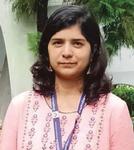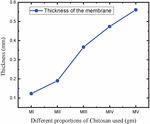Chitosan/NC Based Bio Composite Membrane: An Impact of Varying Amount of Chitosan on Filtration Ability for the Malachite Green Dye
Rekha Goswami1, 2, Abhilasha Mishra3,*, Neha Bhatt3 and Brijesh Prasad4
1Department of Environmental Science, Graphic Era Deemed to be University, Dehradun, India
2Department of Environmental Science, Graphic Hill University, Dehradun, India
3Department of Chemistry, Graphic Era Deemed to be University, Dehradun, India
4Department of Mechanical Engineering, Graphic Era Deemed to be University, Dehradun, India
E-mail: abhi1680@gmail.com
*Corresponding Author
Received 04 August 2021; Accepted 31 March 2022; Publication 07 May 2022
Abstract
This study is generally focused on knowing about which appropriate quantity of chitosan with cellulose nanocrystal gives best output in terms of strength and potential to bear vaccum pressure during filtration study. It was observed that membrane M showed best results in filtering out the malachite green dye present in the aqueous solution of 50 PPM taken during study. The filtration study was observed under three different pH values i.e. 2.0, 5.0 and 9.0 and recorded results depicted that the first five cycles significantly remove the dye concentration ranging from 32-13 PPM, 27-7 PPM and 33-14 PPM respectively. The contact angle results for all the membrane showed hydrophilic behaviour. The thickness and the swelling behaviour also analysed and it was observed that membrane M showed highest thickness (0.56 mm) as well as highest swelling behaviour (1.5) due to presence of high chitosan content in its composition.
Keywords: Chitosan, malachite green dye, hydrophilic, contact angle.
1 Introduction
In the past few decades’ industrial effluent treatment and its management becomes more challenging. The treatment of the industrial effluent is utmost important as it contains various kind of dissolved toxic contaminants, heavy metals, dyes etc. which imposes hazardous effects on flora, fauna as well as in human population also, and it may be found highly fatal because of its carcinogenic, mutagenic behavior (Lin et al., 2011; Huang et al., 2011). Textile, paper and pulp, leather, cosmetic industries used various synthetic dyes for the coloring, dyeing and other purposes. Dyes are present in dissolved form when discharge from industries which found to be highly difficulty to separate it (Mondal 2008). In this experimental study malachite green dye was studied, its synthetic aqueous solution of 50 PPM was prepared in the laboratory. It is the cationic dye and called as N-methylated diaminotriarylmethane. It is usually used in aquaculture as parasiticides, fungicides and as a disinfectant for anti-protozoans etc., (Srivastava et al., 2004). This dye shows various fatalistic outcome if not treated properly, it causes cytotoxic, cancinogenic and teratological threats. (Attallah et al., 2013; Mitter et al., 2012). Biological treatment and chemical precipitation are some commonly used conventional treatment used for the removal of the dyes, whereas malachite green dye have tendency to start fading when it exposed to light and water, cause trouble in removal process (Baek et al., 2010).
In this study the main materials used was chitosan and cellulose nanocrystal used for the membrane composition by casting technique. Cellulose molecules are semicrystalline in behavior containing anhydroglucose units (AGUs) binded with -1, 4-glycosidic bonds. It is one of the renewable resources found in various plants materials such as wood, hemp flax, coconut husk, sisal (Abraham et al., 2013), modified cassava fibers (Egila and Okorie 2002), sour sop seeds (Oboh and Aluyor 2008), coconut shell (Gimba et al., 2001), wolffia globosa (Upatham et al., 2002), animal like tunicates (Peng et al., 2011), various types of algae such as Desmid green alga, Micrasterias rotate, Coldophora, Boerogesenia etc. It is observed that the cellulose content is very high plants biomass in comparison to other resources (Hua et al., 2015). Various type of nanocellulose composition is used in the form of adsorbent, membrane, flocculant, composite beads etc., for the wastewater treatment nano-dimension range of the particle, hydrophilic behavior, non-toxic, cost effective in nature, large surface area etc., are some unique characteristics of the nanomaterials (Rekha et al., 2020). In the past few decades’ agricultural products and it’s by products are significantly used as an adsorbent for the removal of various dyes. In general chitosan falls under the class of polyaminosacchrides. It is formed by the alkaline N-deacetylation of chitin, which mainly comprises of –(l4) linkages of N–acetyl–D–glucosamine and D–glucosamine. The presence of reactive amino and hydroxyl group makes it highly reactive and it shows flexible property when it comes in use for different purposes (Rekha et al., 2021).
In this experimental study we observed the impact of chitosan/NC based composite membrane potential by varying the quantity of chitosan ranging from 0.3 to 0.7 gm during the membrane formulation. pH of the solution also plays vital role in the removal of contamination, so in this study we also evaluate the effect of different pH values in removal efficiency of the malachite green dye.
2 Materials and Methods
2.1 Chemicals Used for Experimental Study
During experiment chitosan/Nanocellulose based composite membrane were formed using chemicals such as Chitosan, cellulose nanocrystals extracted from sugarcane bagasse. Sodium hypochlorite (NaClO) used as a delignification agent, Glacial Acetic Acid (2% v/v) used as dissolving reagent for chitosan, Sulphuric acid (2% v/v) used for hydrolysis purpose and 1N NaOH used as a cross linker to provide strength to the composite membrane. All the chemical and reagents are purchased from Merck and Rankem. In overall experimental study distilled water was used.
2.2 Extraction of Cellulose Nanocrystals (CNCs)
Step 1: Alkali treatment of raw sugarcane bagasse Primarily raw sugarcane bagasse was soaked for 6 h in 2% NaOH solution at RT in order to remove all the dirt, waxes in the cell wall, pectin, lignin and hemicellulose present in the raw material. Using alkali treatment also resulted in enhancing the crystalline behaviour of the nanocellulose.
Step 2: Bleaching process This process mainly involved the disintegration of remaining lignin, hemicellulose, waxes and other impurities etc., results in removal of the amorphous region entirely. Sodium hypochlorite (NaOCl) was used as bleaching agent with continuous stirring under 40C temperature for 6 h. After completing the stirring process, the homogenized solution was neutralized by several wash with distilled water and then after leave the sample for drying in room temperature for 2 days.
Step 3: Acid Hydrolysis of the bleached sugarcane bagasse In this process 2% (v/v) acid solution was used to extract out the intact form of cellulose nanocrystals. Hydrolysis process was maintained by continuous stirring under 50C temperature for 1 h. after completion of hydrolysis the sample cooled and centrifuged at 6500 rpm for 30 mins. The pulp was extracted and then cooled distilled water was added to stop the hydrolysis reaction. Then after, sample was washed several times to attain neutralization of the resulted homogenized solution.
2.3 Formulation and Cross Linking of Chitosan/NC Composite Membranes
In this study varying amount of chitosan (0.3, 0.4, 0.5, 0.6 and 0.7 gm) was taken with cellulose nanocrystal (CNC) to check the efficacy of the nanocomposite membrane for the removal of malachite green dye (refer Table 1). For the formulation of the composite membrane the amount of chitosan was varying from 0.3–0.7 gm with fixed CNCs amount i.e., 1.0 gm. For dissolving chitosan, 2% v/v acetic acid was used as reagent. After mixing all the content it was continuously stirred for 6 h, to obtain homogenised suspension. After this the homogenized suspension was casted into the petridish of mm size and placed into a hot air oven for 16 h at maintained temperature of 60C. When the suspension was completely dry then 1N NaOH was poured over the dried film, for the crosslinking process and kept for 24 h. Next day, crosslinked membrane was washed several times to remove all the unreacted chemical species from its surface, if present and pure composite membrane were formed. Table 1 showing the formulation of nanocomposite membrane and Figure 1 showing the formulated membrane physical appearance.
Table 1 Formulated membrane codes and composition
| Membrane Code | Chitosan Taken (gm) | Cellulose Nanocrystals (gm) |
| M | 0.3 | 1.0 |
| M | 0.4 | 1.0 |
| M | 0.5 | 1.0 |
| M | 0.6 | 1.0 |
| M | 0.7 | 1.0 |
Figure 1 Formulated Chitosan/NC based composite membrane.
3 Characterization
3.1 Contact Angle Measurement
Contact angle measurement was basically done to analyse the hydrophilicity behaviour of the chitosan/NC composite membrane by contact angle system, from Kruss, Germany. In this sessile drop of 10 l volume was poured over the formulated membranes by means of automatic dispenser unit.
3.2 Swelling Index
In general, the swelling index of the membrane tells us about the insolubility of the polymer in various solvent. To check the swelling behaviour of all the composite membrane conventional gravimetric method was adopted to analyse the swelling behaviour in distilled water. In this about 0.10 gm dried composite membrane was taken and immersed in 25 ml distilled water for time duration ranging from 1–5 mins. To evaluate the swelling degree the wet membrane was dried with the help of tissue paper to remove excess water to weigh accurately. Following equation was used for the calculation:
| (1) |
W = Weight of swollen Chitosan/NC nanocomposite film (g) W Weight of initial dried Chitosan/NC nanocomposite film (g)
3.3 Determination of Thickness
The thickness of the chitosan/NC based membranes was measured by using electronic micrometer by clamping the membrane (in between the anvil and spindle) and adjusted with ratchet (refer Figure 2). Taking the accurate reading at different points in the membrane and averaging it.
Figure 2 Digital Micrometre used during study.
3.4 Functional Group Availability in the Chitosan/NC Membrane
To check and detect the functional group availability, the FTIR (Fourier Transform Infrared Spectroscopy) technique was used (Perkin Elmer, L160000V, Waltham, MA, USA) in the frequency range of 4000 cm to 400 cm at room temperature.
3.5 Vaccum Filtration Study
In this study variation was done in the chitosan quantity during formulation of the composite membrane to check its efficacy in removal of malachite green dye. During filtration check it was observed that only membrane which contains 0.5 gm chitosan was fitted for the study. Its efficiency was evaluated by running 100 ml of 50 PPM malachite green dye aqueous solution prepared at laboratory. To check the potential of the membrane the feed solution was run under 8 times cycles. On completing each cycle 10 ml of the filtered solution was collected and analysed by HACH colorimeter (DR 900) instrument (refer Figure 3).
Figure 3 Removal of chromium ion through vaccum filtration unit.
The effect of different pH on the removal rate was also assessed. In this study at three different pH (2.0, 5.0 and 9.0) the filtration efficiency of naocomposite membrane (M) was observed. During this the pH of the feeded solution was adjusted to desirable value with the help of using 1M HCL or 1M NaOH solution.
The amount of malachite green dye adsorbed at each time interval was calculated as:
| (2) |
Where, C is the initial dye concentration C is the final dye concentration, V is the solution volume and m is the mass of adsorbent taken.
The percentage removal of the malachite green dye was calculated as:
| (3) |
4 Result and Discussion
4.1 Contact Angle
On varying the amount of chitosan in formulating the composite membrane, it showed different contact angles between solid liquid interfaces. The observed contact angle for the membranes MI M M M M were 75.3, 76.60, 73.3, 81.8 and 90.30 respectively, refer Figure 4. Observed results denoted that all the membranes showed hydrophilic nature by attaining the contact angle below 90.
Figure 4 Contact angle measurement of Chitosan/NC based composite membrane.
4.2 Swelling Ratio
Water retention ability of the membrane was measured by swelling index ratio. Maximum swelling ratio was attained after 5 mins in case of all the membranes. Highest ratio 1.5 was observed in M membrane (0.7 gm chitosan) and lowest 0.9 in M membrane (0.3 gm chitosan). Observed results depicted in Figure 5 which shows that on increasing chitosan quantity in composite membrane, which eventually enhance its swelling behaviour. In our previous study neat chitosan membrane showed equilibrium in 3–4 min and attaining maximum swelling ratio of 0.6. (Refer Figure 5).
Figure 5 Graph showing swelling ratio of membranes with time durations.
4.3 Determination of Thickness
Membranes with varying amount of the chitosan were evaluated using electronic micrometer for the thickness determination at different points (refer Table 2). Observed results showed maximum thickness of 0.56 mm for the membrane M, which contain about 0.7 gm of chitosan in it, shown in Figure 6. So, it is suggested that on increasing the amount of chitosan the thickness of the membrane going to be increased which makes it more brittle in behaviour.
Table 2 Formulated membrane thickness data
| Weight | Average | ||||||
| of | Thickness Values (mm) | Thickness | |||||
| Membrane | Chitosan (g) | Point 1 | Point 2 | Point 3 | Point 4 | Point 5 | Values (mm) |
| M | 0.3 gm | 0.091 | 0.114 | 0.131 | 0.156 | 0.123 | 0.12 |
| M | 0.4 gm | 0.161 | 0.187 | 0.198 | 0.213 | 0.190 | 0.19 |
| M | 0.5 gm | 0.289 | 0.307 | 0.368 | 0.501 | 0.366 | 0.37 |
| M | 0.6 gm | 0.383 | 0.442 | 0.471 | 0.599 | 0.474 | 0.47 |
| M | 0.7 gm | 0.454 | 0.560 | 0.600 | 0.630 | 0.561 | 0.56 |
Figure 6 Thickness of the composite membranes.
4.4 IR Spectra of Chitosan/NC Based Membrane
To confirm the nanocomposite membrane formulation nanocellulose and Chitosan the IR spectral bands are formed at 3332 cm showing O-H stretching due to intramolecular hydrogen bonding of cellulose molecules. Spectral band at 2919 cm (C-H stretching vibration bond), due to the formation of hydrogen bonding between cellulose nanocrystal and chitosan molecules, presence of 1520 cm spectral band indicating N-H flexural vibration of chitosan, which signifies the successful crosslinking. Band at 1104 cm (C-O-C stretching), 715 cm (out of plane N-H).
Figure 7 IR spectra of the Chitosan NC based membrane.
4.5 Malachite Green Dye Removal During Vaccum Filtration
During experimentation the filtration study was analysed only for the M membrane (0.5 chitosan) due to its capability to withstand the vaccum pressure. Membrane M and M was showed fragile behaviour and low strength whereas Membrane M and M showed the brittle behaviour, thus not fitted for the filtration check. Total eight cycles were run repetitively to check the potential of nanocomposite membrane towards malachite green dye. The removal rate and decrease in concentration was observed under three different pH of 2.0, 5.0 and 9.0. It was reported that first five cycles in all pH condition showed significant change in the removal rate and concentration decrease ranging from 35–74% and 32–13 PPM (pH 2.0); 46–85% and 27–7 PPM (pH 5.0); 33–71% and 33–14 PPM (pH 9.0) respectively.
At pH 5.0 highest overall removal rate i.e., 84% and concentration decrease i.e., 7.0 PPM was observed. After fifth cycle the filtration results showed consistency may be due to gradual clogging of the pores which results in creating hindrance in filtration efficiency shown in Figure 7.
Figure 8 Removal rate and concentration variation in malachite green dye.
5 Conclusion
Chitosan and nanocellulose shows versatile characteristics in the wastewater remediation. In order to achieve decrease in load the waste generation after the treatment both the polymers have capability to degrade biologically with less or no residue after regeneration process. This kind of membrane formulation would be very helpful to cope up with wastewater treatment techniques. In this study membrane M (0.5 gm) was the best fitted membrane and found to be much accurate with cellulose nanocrystal to formulate the membrane for the removal of dye from aqueous solution. In the past few year’s nanotechnology gain immense popularity in field of wastewater treatment. Membrane with the composition of chitosan and cellulose nanocrystal found to be reliable for the removal of dye with zero liquid discharge.
References
Abraham, E., Deepa, B., Pothen, L. A., Cintil, J., Thomas, S., John, M. J., and Narine, S. S. (2013). Environmental friendly method for the extraction of coir fibre and isolation of nanofibre. Carbohydrate polymers, 92(2), 1477–1483.
Attallah, M. F., Ahmed, I. M., and Hamed, M. M. (2013). Treatment of industrial wastewater containing Congo Red and Naphthol Green B using low-cost adsorbent. Environmental Science and Pollution Research, 20(2), 1106–1116.
Baek, M. H., Ijagbemi, C. O., Se-Jin, O., and Kim, D. S. (2010). Removal of Malachite Green from aqueous solution using degreased coffee bean. Journal of hazardous materials, 176(1–3), 820–828.
Egila, J. N., and Okorie, E. O. (2002). Influence of pH on the Adsorption of trace metals on ecological and agricultural adsorbents. J. Chem. Soc. Niger, 27, 95–98.
Gimba, C. E., Olayemi, J. Y., Ifijeh, D. O. H., and Kagbu, J. A. (2001). Adsorption of Dyes by powdered and granulated activated carbon from coconut shell. J. Chem. Soc. Niger, 26(1), 23–27.
Goswami, R., Mishra, A., Bhatt, N., Mishra, A., and Naithani, P. (2021). Potential of chitosan/nanocellulose based composite membrane for the removal of heavy metal (chromium ion). Materials Today: Proceedings.
Goswami, R., Mishra, A., Bhatt, N., and Naithani. P. (2020). Removal of chromium ion using nanocellulose based adsorbent. Journal of Critical Reviews., 7, 4148–4155.
Hua, K., Strømme, M., Mihranyan, A., and Ferraz, N. (2015). Nanocellulose from green algae modulates the in vitro inflammatory response of monocytes/macrophages. Cellulose, 22(6), 3673–3688.
Huang, C. H., Chang, K. P., Ou, H. D., Chiang, Y. C., and Wang, C. F. (2011). Adsorption of cationic dyes onto mesoporous silica. Microporous and Mesoporous Materials, 141(1–3), 102–109.
Lin, Y. F., Chen, H. W., Chien, P. S., Chiou, C. S., and Liu, C. C. (2011). Application of bifunctional magnetic adsorbent to adsorb metal cations and anionic dyes in aqueous solution. Journal of Hazardous Materials, 185(2–3), 1124–1130.
Mitter, E. K., Dos Santos, G. C., de Almeida, É. J. R., Morão, L. G., Rodrigues, H. D. P., and Corso, C. R. (2012). Analysis of acid alizarin violet N dye removal using sugarcane bagasse as adsorbent. Water, Air, and Soil Pollution, 223(2), 765–770.
Mondal, S. (2008). Methods of dye removal from dye house effluent—an overview. Environmental Engineering Science, 25(3), 383–396.
Oboh, O. I., and Aluyor, E. O. (2008). The removal of heavy metal ions from aqueous solutions using sour sop seeds as biosorbent. African Journal of Biotechnology, 7(24).
Peng, B. L., Dhar, N., Liu, H. L., and Tam, K. C. (2011). Chemistry and applications of nanocrystalline cellulose and its derivatives: a nanotechnology perspective. The Canadian journal of chemical engineering, 89(5), 1191–1206.
Srivastava, S., Sinha, R., and Roy, D. (2004). Toxicological effects of malachite green. Aquatic toxicology, 66(3), 319–329.
Upatham, E. S., Boonyapookana, B., Kruatrachue, M., Pokethitiyook, P., and Parkpoomkamol, K. (2002). Biosorption of cadmium and chromium in duckweed Wolffia globosa. International Journal of Phytoremediation, 4(2), 73–86.
Biographies

Rekha Goswami is research scholar at Graphic Era Deemed to be University since 2019. She has done her master in Environmental Science from HNB Garhwal University in 2014. Her research areas are nanomaterials, nanocel- lulose membrane and waste water treatment.

Abhilasha Mishra presently working as Associate Professor in Chemistry Department of Graphic Era Deemed University, Dehradun. She has completed her MSc. From Chemistry department RDVV University in 2002 and done her Ph.D. from RDVV university in 2007. She is having 14 years of Teaching and research experience. Her research areas includes nanomate- rials, nanostructured smart coatings, biomaterials, water remediation using nanomaterials and solar cell efficiencies.

Neha Bhatt is research scholar at Graphic Era Deemed to be University since 2018. She has done her master in Chemistry from University of Delhi in 2015. Her research areas are nanomaterials, synthesis of different material and nanostructured coating, super-hydrophobic antireflective coating.

Brijesh Prasad is associated with the Department of Mechanical Engineering at Graphic Era Deemed to be University, Dehradun Uttarakhand, India as an Assistant Professor. Dr. Brijesh Prasad, presently working as a postdoc fellow with Institute of Advanced Materials, IAAM (Sweden). His research area covers the development of smart nanocomposite materials for energy harvesting and sensing applications for soft electronic devices.
Journal of Graphic Era University, Vol. 10_2, 117–132.
doi: 10.13052/jgeu0975-1416.1024
© 2022 River Publishers















